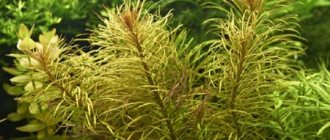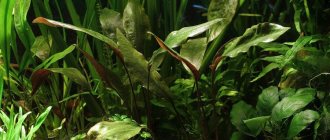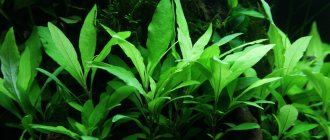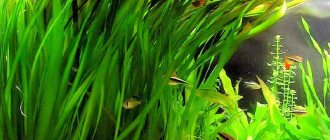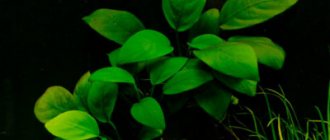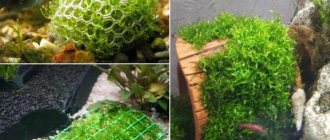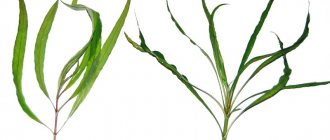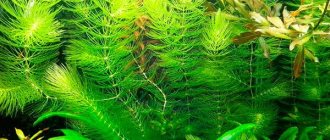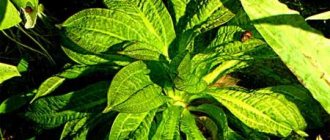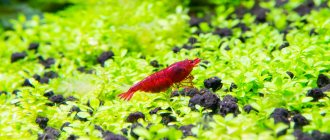Description
In nature, elodea is capable of stretching as much as 3 meters in length, while simultaneously sending out shoots in different directions. This is where the name “water plague” comes from, since this plant grows quickly and is capable of displacing the rest of the flora from the reservoir at such a pace in the near future. This plant can be found in North America, but thanks to humans, it can now be seen in a variety of bodies of water around the world.
Elodea has an interesting appearance. The leaves have an emerald color, and at the same time they are translucent, and in the light they are completely translucent. The stems have a light green or brownish tint. Leaves in whorls are attached to them. They have a pointed shape with jagged edges, and the size does not exceed 1 cm.
During the hot season, this plant is capable of blooming. It is dioecious, so the flowers bloom either female or male. However, this applies only to natural elodea. In aquariums it is only female. The petals are oval in shape.
The root system of this plant is weak. It takes root in the ground thanks to rhizoids. Beginning aquarists do not notice the difference and still call them roots.
Elodea canadensis
Spreading
Elodea canadensis is a perennial freshwater plant from the family Aquaticaceae . Elodea is native to the cool waters of North America. Thanks to man, elodea has spread throughout the globe. Its green branches can be found in water bodies of Eurasia, Africa and Australia. It can grow in almost any place where there is water and sunlight, and elodea grows very, very quickly, literally taking over the entire body of water and drowning out the growth of other plants, for which it received the name “water plague.” It has another name - anacharis.
general description
Elodea has long and branched vine-like stems that are covered with small oval leaves that are collected in whorls.
Young stems are bright green, but change color to dark green as they age. The stems of this plant are brittle, but have an amazing ability to regenerate. You can break the stem into pieces, each five centimeters long, and from each fragment a full-fledged plant will grow in three to four weeks. Elodea canadensis can spread along the bottom of a reservoir , or it can float on the surface. In the cold season, it sinks to the bottom and sheds its leaves, sprouting buds remain on the stem, from which new shoots grow as the weather warms up. But in a warm aquarium the plant grows throughout the year.
Optimal conditions in the aquarium
"Water plague" can survive in almost any aquarium, but it will be better if it lives rather than survives, so it is necessary to create optimal conditions for it in the aquarium.
Elodea
The aquarium microclimate should replicate the conditions of water bodies of temperate latitudes. The best conditions for anacharis will be:
- Temperature from 15 to 23 degrees. In warmer water, the plant does not feel very good, its growth slows down, and in water colder than 14 degrees, elodea begins to prepare for wintering, this is expressed in stopping growth and shedding leaves.
- Soft water. The hardness and acidity of the water do not matter much, however, if Elodea is transferred from an aquarium with soft water to an aquarium with hard water, it may die. However, it tolerates transplanting from hard water to soft water without problems. When replanting, you need to recreate all the conditions that were in the old place.
- No turbidity. The aquarium plant Elodea is very afraid of turbidity; suspended particles settle on its leaves, blocking access to the sun's rays (or lamp light), which leads to a stop in photosynthesis and death.
- Bright and uniform lighting. In an aquarium where this plant grows, you need to ensure that the light evenly illuminates the entire surface of the aquarium. If there is more light in one corner than in the other, then where there is a lot of light, the plant will be green and alive, but the shoots located in the dark corner will soon turn brown, shed their leaves and die.
all their nutrients from water by filtering it.
The current in the aquarium should be slow; if it is strong, then all the shoots will simply be “blown away” into one corner, where they will turn into an ugly lump.
Content
The growth rate and appearance of elodea directly depends on the conditions in which it will be kept. For this it is necessary to provide the following:
Lighting . All varieties of this plant love light. Of course, they won’t die from a little shade, but their growth rate will drop significantly. Therefore, it is advisable to provide them with at least 10 hours of daylight;
Temperature . This plant is quite versatile and unpretentious. It can withstand a temperature range of 16-24 degrees. But, of course, a higher figure is better;
Hardness and acidity . They don't really matter. Elodea is able to adapt to any conditions. The main thing is that the water is not salty. Otherwise, she may quickly die;
Priming. It is also unimportant, since, as mentioned above, elodea does not have a developed root system and feeds in a different way;
Fishes. Any small fish whose diet is food of animal origin will do.
Accordingly, it is not worth planting goldfish and the like, since they can quickly eat the plant. Of course, with the right diet, they will not touch it, but not all aquarists are able to provide a good menu for these fish.
Elodea history of appearance in the aquarium and general description of the species
Elodea, Latin name Elodea canadensis belongs to the genus Elodea. Its appearance in Europe and our country is associated with human activity. That is, this type of aquatic plant came to us artificially, one might say. Whether this happened intentionally or not is unknown for sure. There are many such examples in history. When a plant or animal enters a region where it has never been seen before. And under good conditions, it multiplies quickly, displacing local species. That is why Elodea was called “water plague” in Europe. Since it was introduced into a lake or pond, it multiplied very quickly, suppressing other plant species and filling the entire reservoir. The original historical homeland of elodea is Canada and America.
How to plant correctly?
Considering that elodea does not have roots, as such, they root it in non-standard ways. For example, you can simply throw a stem into water and wait for rhizoids to begin to grow from it after a while. Alternatively, you can immediately plant the shoot in the ground and cover it well. Then after a while it will begin to cling to the stones itself. The growth of rhizoids directly depends on the water level in the aquarium.
We recommend visiting the section: Floating aquarium plants
Benefits for the aquarium
Small species of fish will find shelter in dense thickets. Pregnant females will find a secluded place to spawn, and fry will be able to hide behind bushy stems from adults. With enough daylight, Elodea will produce large amounts of oxygen , which will serve as an excellent addition to aquarium filtration.
Benefits and harms
Elodea is found in many aquariums around the planet. It is extremely useful and has a number of advantages:
- It looks beautiful and creates picturesque and exotic thickets;
- The plant serves as a shelter for small fish, fry, pregnant females and shrimp;
- With good lighting, elodea produces a lot of oxygen, and therefore in aquariums with it, an aeration system is not always needed;
- The plant cleanses well into water. For a high growth rate, it needs to absorb nitrates, phosphates and potassium. The first two in excess can poison aquarium inhabitants. Therefore, this type of underwater flora is an excellent biological filter;
- Elodea can serve as food for some fish. For example, goldfish, ancistrus, angelfish, etc. can eat it.
However, with all the benefits of this plant, there are disadvantages that should be taken into account. It reproduces by cuttings, and therefore for the growth of a new shoot it is enough to break off a piece of the stem from the mother bush. However, under no circumstances should you do this.
You can plant elodea by securing it in glass rods that act as weights.
This is explained by the fact that the stems of the plant contain juice, which is poisonous to some underwater inhabitants. Therefore, when a bush is broken, the juice gets into the water, which can cause irreparable damage. Therefore, such operations should be carried out outside the general aquarium, in a separate container with water.
Is it good or bad for the aquarium?
Basically, algae brings benefits to the aquarium, which are as follows:
- Dense thickets of the Water Plague provide an excellent refuge for small fish;
- Algae perfectly filters the water space and cleanses it of harmful substances;
- The plant has good photosynthesis due to its love for bright light. Thanks to this, it perfectly saturates the water with oxygen;
- The overgrown leaves of Elodea act as food for some species of fish and mammals living in the aquarium.
Elodea
There are also disadvantages to this algae:
- Since Elodea is capable of absorbing harmful substances, you should not plant a plant from a river or wild pond in an aquarium; it may contain heavy metals or other harmful compounds that will negatively affect the condition of the living creatures in the aquarium.
- Water plague contains poisons that can kill young animals, and large fish are at risk of intoxication, but this is provided that the aquarium plant is cut directly in the water.
- The algae grows quickly , filling the entire territory of the aquarium, as a result it becomes crowded for the fish, so it is necessary to regularly thin out the thickets of Elodea.
Reproduction
Propagated by cuttings. Over time, young cuttings are formed from the mother plant. When the shoots reach 20 cm in height, they can be separated and released into independent swimming. Under favorable conditions, elodea can bloom on the surface of a reservoir. The flowers are white and have oval-shaped seeds. The photo shows a blooming elodea:
Botanical description
Elodea is different from other types of algae. If representatives of this group have a solid cell mass, then Elodea has visible organs - root, stem, leaves, flower, which are clearly distinguishable.
It is often used to study the structure of a cell, since a section of a leaf under a microscope clearly shows the movement of the cytoplasm, which accelerates or slows down with changes in temperature.
Externally, the plant resembles a tropical liana. It has a white thin root system that helps to anchor itself at the bottom of the reservoir. The stems are cord-like, branching, very fragile. The length of the shoot can reach two meters. The stems spread along the bottom and send out vertical shoots that form dense thickets.
The leaf blades are lanceolate or oblong in shape with a pointed tip and serrated edges. The leaf length is 1 cm. The leaves are transparent and transmit light well. Their surface is painted bright green. The leaves are collected in dense whorls of 3 pieces; at the top of the shoot there are lighter and more delicate young leaves.
In summer, the algae begins its flowering period. The flowers are single, rather large, with white petals, blooming on a thin, hard peduncle. Elodea is a dioecious plant, meaning it has male and female flowers. Female specimens have three petals inside and outside, red or green sepals and a bright crimson stigma with fringed edges. The male flower has 9 anthers and 20 ovules.
In the aquarium hobby, only female plants have become widespread, so algae do not produce seeds.
How does it reproduce
In nature, Elodea, being dioecious, that is, having different flowers on different individuals - male or female, is capable of reproducing by seeds.
And among the specimens brought to Europe back in the middle of the century before last, only individuals with female flowers were present. And until now only the female variety is present in aquariums. Therefore, this plant is propagated today exclusively by cuttings , which no one regrets, since this process proceeds surprisingly quickly, easily and reliably, without much effort on the part of aquarists.
Read the description and features of caring for such aquarium plants as pogostemon (Helfera, octopus, erectus) and hemianthus (Cuba, micranthemoides).
With the exception, of course, of the requirement for them not to separate cuttings from the main plant directly in a working aquarium.
Tips for aquarists
Currently, Elodea is being replaced by other ornamental plants. It continues to be kept in aquariums due to its beneficial properties. She is not susceptible to diseases, so she does not require special care.
In order for the plant to become a real decoration for your home aquarium, you should listen to the advice of experienced aquarists:
- for planting, use soil that does not contain foreign impurities and silt; additions of coal and lime are desirable;
- for active growth, use additional lighting sources;
- to give an attractive appearance, “fluffy” tops should be used for rooting;
- control growth by periodically thinning the thickets and trimming the tops;
- The optimal planting location is near the compressor, which will dissipate the carbon dioxide produced by the algae.
Source: Aquarium plant Elodea: types and conditions of detention
Using Elodea
Elodea is an indispensable plant in aquariums and small standing ponds in the garden. It effectively greens the pond, serves as food for fish and a refuge for fry. The green mass grows quickly; you just need to periodically remove its excess.
As a result of photosynthesis, a large volume of greenery releases a lot of oxygen, which enriches the water. The role of elodea as a natural filter is very important. It collects suspended matter, absorbs harmful substances and prevents the development of putrefactive bacteria.
In an aquarium, a green mass with lacy leaves is often placed in the background. It creates a wonderful backdrop for plants with larger leaves.
Aroid plants.
Of the anubias, I would like to recommend only one species as an unpretentious plant for beginning aquarists - Anubias barteri var. nana and its varieties - “Petite”, nana “round leaves”, etc. This is a dwarf variety of the very variable species Anubias Bartera, which does not experience any problems when constantly kept underwater in an aquarium and is very undemanding to the conditions. For novice aquarists, this Anubias is very attractive for its shade tolerance, the ability to live not only planted in the ground, but also attached to a stone or driftwood, as well as its slow growth, which allows its care to be reduced only to the infrequent removal of yellowed or rotten leaves. The features of this very rewarding plant, which we have already talked about in the article about the “slow aquarium,” allow you to create voluminous, expressive aquarium compositions from it and use it as the main “framework” for the design of a novice hobbyist’s aquarium. The exceptional endurance of this anubias is explained by the fact that in nature it grows in the coastal zone of unstable water bodies in West Africa, periodically finding itself in water of varying purity and composition, and even in the air. The only thing that Anubias nana does not like in an aquarium is too much light, in which its leaves begin to become covered with green algae, so plant Anubias in the shade, under thickets of Elodea or Vallisneria. The hard, leathery leaves of Anubias are rarely damaged by fish, and therefore it can be planted even with plant-unfriendly species such as African cichlids and medium-large breeds of goldfish. And in good conditions, dwarf anubias is sometimes able to delight the lover with underwater flowering, producing an elegant white flower that looks like a miniature calla or calla.
Anubias Bartera "Dwarf", Anubias nana Anubias Bartera dwarf Anubias Bartera dwarf on driftwood Anubias Bartera "Little" Cryptocoryne Wendt "Tropica" Cryptocoryne Wendt "Mi Oya"
Another group of aroids that do well in beginner hobbyist aquariums are the Cryptocorynes . Of course, not all! Some cryptocorynes are very capricious and whimsical, but numerous color varieties of Cryptocoryne wendtii, as well as species such as Cryptocoryne willisii, Cryptocoryne affinis, Cryptocoryne pontederiifolia, Cryptocoryne aponogetifolia, steam va (Cryptocoryne parva ) and some others - are quite suitable as plants for your first aquarium.
Apart from C.affinis and C.aponogetifolia, the rest of the species listed above are small plants, with leaves no more than 10-12 cm long, quite suitable for the foreground. Unlike most rosette plants, cryptocorynes relatively easily tolerate damage to the roots when transplanted from place to place within the same aquarium, quickly take root and begin to grow. But with a sudden transfer from one aquarium to another, a strong (from 30% and above) water change, and especially when transported to another area with a different salt composition of tap water - Cryptocoryne (especially Cryptocoryne affinis) sometimes experiences osmotic shock, leading to the immediate shedding of most or almost all leaves. Of course, this phenomenon (called “cryptocoryne disease” in the literature) should be avoided if possible, but even if this happens, it’s not scary: the plant will have enough strength to soon grow a new rosette of leaves in a new place.
Cryptocorynes do not really like new, newly launched aquariums, with completely washed soil and a low organic content. However, as the lower layers of soil silt, they begin to grow much more cheerfully and willingly. The best fertilizer for these plants, which naturally grow in small reservoirs of tropical peat bogs, is natural fish waste that has sunk into the ground. They grow especially well in aquariums inhabited by viviparous fish - platies, swordtails, and mollies. With good lighting and sufficient nutrition, many types of cryptocorynes turn the lower part of the leaf blade into a thick brown, dark red, and even burgundy color. This is evidence of the very good condition of the plants.
Cryptocorynes reproduce in the same way as Vallisneria - by shoots formed on long horizontal shoots, but only in Cryptocorynes these shoots usually grow under the surface of the soil and rarely form more than 1-2 daughter plants on one shoot. When transplanted, such shoots (even those that have not yet produced daughter plants) easily break off and remain in the ground. Such a “hidden” shoot can then germinate into a new plant after a long time, unexpectedly delighting the aquarist with a new cryptocoryne where the old one once sat. In good conditions, in old silted aquariums, cryptocorynes form daughter plants at a short distance from the mother, growing into dense, dense thickets.
- Cryptocoryne aponoghetonolifolia
- Cryptocoryne Wendt - "Green"
- Cryptocoryne Wendt - "Green Gecko" in a pot
- Cryptocoryne Wendt - "Brown"
- Cryptocoryne Wendt - “Broadleaf”
- Cryptocoryne Wendt various.
- Cryptocoryne Vendta dwarf
- Cryptocoryne Willis
- Cryptocoryne pontederifolia
- Cryptocoryne related
- Cryptocoryne cordate
View photo report >>
As they gain experience in working with the plants listed in this article, novice aquarists can add other, more whimsical and more interesting plants to their aquariums, many of which we will discuss in future articles.
© Aqua Logo Andrey Klochkov
Fields marked with * are required.
